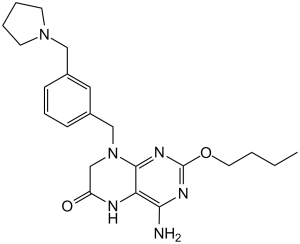Vesatolimod (GS-9620)
This product is for research use only, not for human use. We do not sell to patients.

For small sizes, please check our retail website as below: www.invivochem.com
| Size | Price | Stock |
|---|---|---|
| 250mg | $780 | Check With Us |
| 500mg | $1350 | Check With Us |
| 1g | $2025 | Check With Us |
Cat #: V1860 CAS #: 1228585-88-3 Purity ≥ 98%
Description: Vesatolimod (formerly known as GS9620; GS-9620) is a novel potent, selective and orally bioactive small molecule agonist of Toll-like receptor 7 (TLR-7) with antiviral activity.
Top Publications Citing Invivochem Products
Publications Citing InvivoChem Products
Product Promise

- Physicochemical and Storage Information
- Protocol
- Related Biological Data
- Stock Solution Preparation
- Quality Control Documentation
| Molecular Weight (MW) | 410.52 |
|---|---|
| Molecular Formula | C22H30N6O2 |
| CAS No. | 1228585-88-3 |
| Storage | -20℃ for 3 years in powder formr |
| -80℃ for 2 years in solvent | |
| Solubility In Vitro | DMSO: >4 mg/mLr |
| Water: <1 mg/mLr | |
| Ethanol: <1 mg/mL | |
| SMILES Code | O=C1NC2=C(N)N=C(OCCCC)N=C2N(CC3=CC=CC(CN4CCCC4)=C3)C1 |
| Synonyms | GS9620; GS 9620; GS-9620 |
| Protocol | In Vitro | Vesatolimod (GS-9620) rapidly internalizes into cells and preferentially localizes to and signals from endo-lysosomal compartments. To test this hypothesis, the kinetics of cellular uptake of the compound in Daudi cells using tritiated Vesatolimod (3H-GS-9620) is measured. The kinetics of 3H-GS-9620 accumulation is rapid, reaching concentration-dependent steady-state equilibrium in approximately thirty minutes. Measured intracellular concentration of 3H-Vesatolimod is 5-fold higher than the extracellular concentration of 3H-GS-9620 used to treat cells. Increases in intracellular 3H-Vesatolimod concentrations are roughly proportional with increasing concentrations of 3H-GS-9620. |
|---|---|---|
| In Vivo | Single oral doses of Vesatolimod (GS-9620) at 0.3 and 1 mg/kg in uninfected chimpanzees demonstrates a dose- and exposure-related induction of serum IFN-α, select cytokines/chemokines, and IFN-stimulated genes (ISG) in the peripheral blood and liver. Following oral administration at 0.3 (n=3), and 1 mg/kg (n=3 and n=4), Vesatolimod (GS-9620) Cmax is 3.6±3.5, 36.8±34.5, and 55.4±81.0 nM, respectively. Peak serum IFN responses occur at 8 h post-dose. The mean peak levels of induced serum IFN-α are 66 and 479 pg/mL at doses of 0.3 and 1 mg/kg, respectively. Vesatolimod (GS-9620) treatment induces ISG transcripts including ISG15, OAS-1, MX1, IP-10 (CXCL10), and I-TAC (CXCL11) in peripheral blood mononuclear cells (PBMC) at 0.3 mg/kg and in both PBMC and the liver at 1 mg/kg. |
These protocols are for reference only. InvivoChem does not
independently validate these methods.
| Solvent volume to be added | Mass (the weight of a compound) | |||
|---|---|---|---|---|
| Mother liquor concentration | 1mg | 5mg | 10mg | 20mg |
| 1mM | 2.4359 mL | 12.1797 mL | 24.3593 mL | 48.7187 mL |
| 5mM | 0.4872 mL | 2.4359 mL | 4.8719 mL | 9.7437 mL |
| 10mM | 0.2436 mL | 1.2180 mL | 2.4359 mL | 4.8719 mL |
| 20mM | 0.1218 mL | 0.6090 mL | 1.2180 mL | 2.4359 mL |
The molarity calculator equation
Mass(g) = Concentration(mol/L) × Volume(L) × Molecular Weight(g/mol)
Mass
=
Concentration
×
Volume
×
Molecular Weight*
The dilution calculator equation
Concentration(start)
×
Volume(start)
=
Concentration(final)
×
Volume(final)
This equation is commonly abbreviated as: C1 V1 = C2 V2
Concentration(start)
C1
×
Volume(start)
V1
=
Concentration(final)
C2
×
Volume(final)
V2
Step One: Enter information below
Dosage mg/kg
Average weight of animals g
Dosing volume per animal µL
Number of animals
Step Two: Enter the in vivo formulation
%DMSO
+
%
+
%Tween 80
+
%ddH2O
Calculation Results:
Working concentration:
mg/ml;
Method for preparing DMSO master liquid:
mg
drug pre-dissolved in
µL
DMSO(Master liquid concentration
mg/mL)
,Please contact us first if the concentration exceeds the DMSO solubility of the batch of drug.
Method for preparing in vivo formulation:
Take
µL
DMSO master liquid, next add
µL
PEG300, mix and clarify, next add
µL
Tween 80,mix and clarify, next add
µL
ddH2O,mix and clarify.
Note:
- (1) Please be sure that the solution is clear before the addition of next solvent. Dissolution methods like vortex, ultrasound or warming and heat may be used to aid dissolving.
- (2) Be sure to add the solvent(s) in order.




































